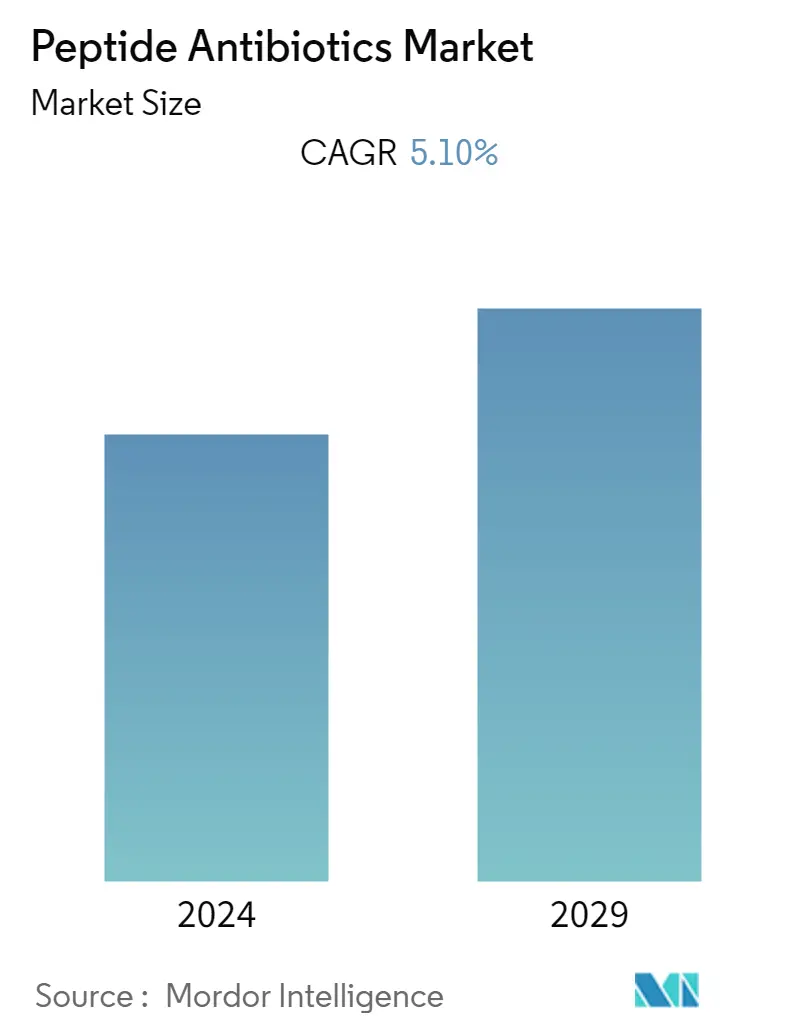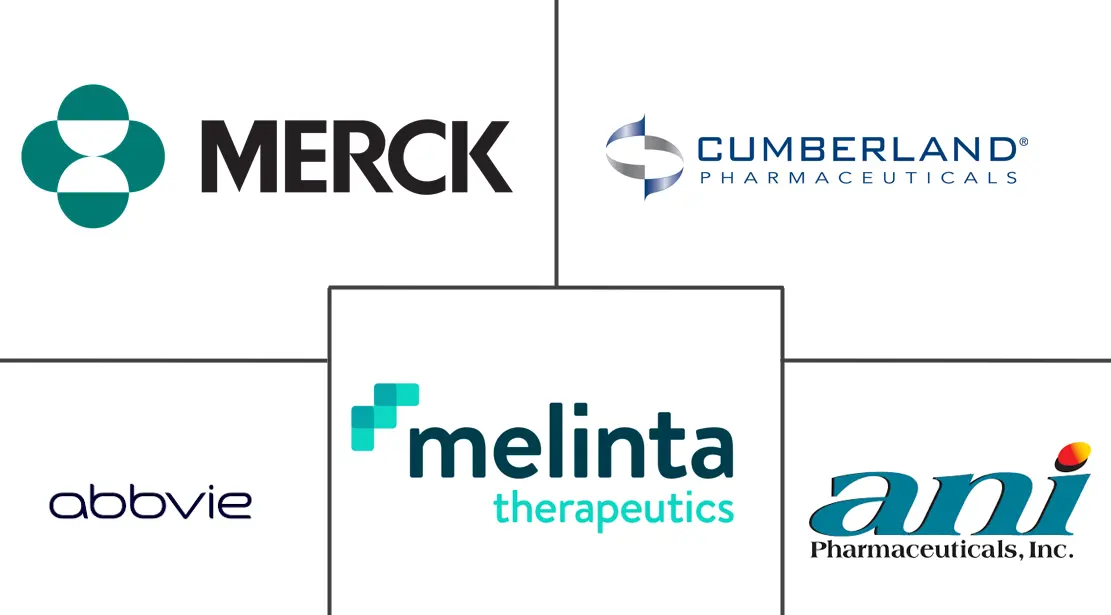Market Size of Peptide Antibiotics Industry

| Study Period | 2019 - 2029 |
| Base Year For Estimation | 2023 |
| CAGR | 5.10 % |
| Fastest Growing Market | Asia-Pacific |
| Largest Market | North America |
| Market Concentration | Medium |
Major Players
*Disclaimer: Major Players sorted in no particular order |
Peptide Antibiotics Market Analysis
The Peptide Antibiotics Market is anticipated to witness steady growth of 5.1% CAGR over the forecast period.
The COVID-19 pandemic had a substantial impact on the peptide antibiotics market initially. The strict lockdowns and government regulations intended to slow down the spread of COVID-19 resulted in a decrease in the number of patient visits and subsequently hampering the number of prescriptions for peptide antibiotics. Various fungal and bacterial infections remained undiagnosed and untreated due to the strict lockdown. During this period outpatient clinics were closed or operating with limited appointments which resulted in a reduction of in-person visits. The number of antibiotic prescriptions was hampered due to the result of the decline in patient visits. According to a research study published in the Infectious Diseases Society of America in October 2021, the total number of outpatient antibiotic prescriptions decreased by 37.1% during March-December 2020 as compared to the prescriptions provided during March-December 2019.
Moreover, the significant increase in the number of patients suffering from antimicrobial resistance significantly hampered the market growth during the COVID-19 period. According to the report published by the Centers for Disease Control and Prevention, more than 29,400 people died from antimicrobial-resistant infections during the first year of the pandemic (2020). Thus, the COVID-19 outbreak affected the market's growth adversely in its preliminary phase; however, the market is expected to gain traction due to the significant increase in the use of telehealth and telemedicine globally.
Further, the increase in the number of product approvals, surge in the number of patients suffering from various infectious diseases and growing adoption of peptide antibiotics in healthcare settings are among the major factors driving the growth of the studied market. This along with the rising number of patients developing antibiotic resistance is also fueling the utilization of peptide antibiotics. According to the report published by European Centre for Disease Prevention and Control (ECDC) in January 2022, every year more than 670,000 cases of infections due to bacteria resistant to antibiotics are registered in European countries and around 33,000 people deaths occur due the antibiotic resistance.
Moreover, the surge in the prevalence of hospital-acquired infections along with the significant increase in skin and bloodstream infections are anticipated to boost the adoption of peptide antibiotics in the management of infection, thereby contributing to the studied market growth. According to the report published by World Health Organization in 2022, every year 8.9 million healthcare-acquired infections occur in acute and long-term facilities across European countries. Moreover, the side effects associated with the use of peptide antibiotics are anticipated to hamper market growth.
Peptide Antibiotics Industry Segmentation
As per the scope of the report, peptide antibiotic products are commonly used in the management of various infectious diseases. These antibiotics are less toxic and highly effective as compared to the other antibiotics. The peptide antibiotics market is segmented by Product Type (Ribosomal Synthesized Peptide Antibiotics and Non-Ribosomal Synthesized Peptide Antibiotics), Disease (Skin Infection, HABP/VABP, Blood Stream Infection, and Others), Route of Administration (Injectable, Topical, and Others), Distribution Channel (Hospital Pharmacies, Retail Pharmacies, and Online Pharmacies), and Geography (North America, Europe, Asia-Pacific, Middle East and Africa, and South America). The market report also covers the estimated market sizes and trends for 17 different countries across major regions, globally. The report offers the value (in USD million) for the above segments.
| By Product Type | |
| Ribosomal Synthesized Peptide Antibiotics | |
| Non-Ribosomal Synthesized Peptide Antibiotics |
| By Disease | |
| Skin Infection | |
| HABP/VABP | |
| Blood Stream Infection | |
| Others |
| By Route of Administration | |
| Injectable | |
| Topical | |
| Others |
| By Distribution Channel | |
| Hospital Pharmacies | |
| Retail Pharmacies | |
| Online Pharmacies |
| Geography | ||||||||
| ||||||||
| ||||||||
| ||||||||
| ||||||||
|
Peptide Antibiotics Market Size Summary
The peptide antibiotics market is poised for steady growth, driven by several key factors. The initial impact of the COVID-19 pandemic was significant, with lockdowns and regulations leading to a decrease in patient visits and antibiotic prescriptions, which adversely affected market growth. However, the market is expected to recover and gain traction due to the increased adoption of telehealth and telemedicine. The rising prevalence of antimicrobial resistance and the growing number of product approvals are contributing to the market's expansion. The surge in hospital-acquired infections and the increasing adoption of peptide antibiotics in healthcare settings further bolster market growth. Despite the challenges posed by side effects associated with peptide antibiotics, the market is supported by the growing need for effective treatments against resistant infections.
The non-ribosomal synthesized peptide antibiotics segment is anticipated to dominate the market, driven by the increasing use of these antibiotics in managing bacterial infections and the rising incidence of skin infections. The demand for non-ribosomal synthesized peptide antibiotics is further propelled by ongoing research and development activities aimed at addressing chronic diseases. North America is expected to lead the market, supported by a high incidence of skin infections and a robust healthcare infrastructure. The presence of key players and continuous product approvals in the region contribute to its dominance. The market is moderately fragmented, with several international and local companies competing for market share, including Merck & Co., Inc., ANI Pharmaceuticals, Inc., and Melinta Therapeutics, among others.
Peptide Antibiotics Market Size - Table of Contents
-
1. MARKET DYNAMICS
-
1.1 Market Overview
-
1.2 Market Drivers
-
1.2.1 Increasing Prevalence of Infectious Diseases
-
1.2.2 Development of Advanced Products
-
1.2.3 Growing adoption of Peptide Antibiotics in in hospitals and clinics
-
-
1.3 Market Restraints
-
1.3.1 Side-effects associated with peptide antibiotics
-
-
1.4 Porter's Five Force Analysis
-
1.4.1 Threat of New Entrants
-
1.4.2 Bargaining Power of Buyers/Consumers
-
1.4.3 Bargaining Power of Suppliers
-
1.4.4 Threat of Substitute Products
-
1.4.5 Intensity of Competitive Rivalry
-
-
-
2. MARKET SEGMENTATION (Market Size by Value - USD million)
-
2.1 By Product Type
-
2.1.1 Ribosomal Synthesized Peptide Antibiotics
-
2.1.2 Non-Ribosomal Synthesized Peptide Antibiotics
-
-
2.2 By Disease
-
2.2.1 Skin Infection
-
2.2.2 HABP/VABP
-
2.2.3 Blood Stream Infection
-
2.2.4 Others
-
-
2.3 By Route of Administration
-
2.3.1 Injectable
-
2.3.2 Topical
-
2.3.3 Others
-
-
2.4 By Distribution Channel
-
2.4.1 Hospital Pharmacies
-
2.4.2 Retail Pharmacies
-
2.4.3 Online Pharmacies
-
-
2.5 Geography
-
2.5.1 North America
-
2.5.1.1 United States
-
2.5.1.2 Canada
-
2.5.1.3 Mexico
-
-
2.5.2 Europe
-
2.5.2.1 Germany
-
2.5.2.2 United Kingdom
-
2.5.2.3 France
-
2.5.2.4 Italy
-
2.5.2.5 Spain
-
2.5.2.6 Rest of Europe
-
-
2.5.3 Asia-Pacific
-
2.5.3.1 China
-
2.5.3.2 Japan
-
2.5.3.3 India
-
2.5.3.4 Australia
-
2.5.3.5 South Korea
-
2.5.3.6 Rest of Asia-Pacific
-
-
2.5.4 Middle East and Africa
-
2.5.4.1 GCC
-
2.5.4.2 South Africa
-
2.5.4.3 Rest of Middle East and Africa
-
-
2.5.5 South America
-
2.5.5.1 Brazil
-
2.5.5.2 Argentina
-
2.5.5.3 Rest of South America
-
-
-
Peptide Antibiotics Market Size FAQs
What is the current Peptide Antibiotics Market size?
The Peptide Antibiotics Market is projected to register a CAGR of 5.10% during the forecast period (2024-2029)
Who are the key players in Peptide Antibiotics Market?
Merck & Co., Inc., ANI Pharmaceuticals, Inc., Melinta Therapeutics. , AbbVie and Cumberland Pharmaceuticals Inc. are the major companies operating in the Peptide Antibiotics Market.

